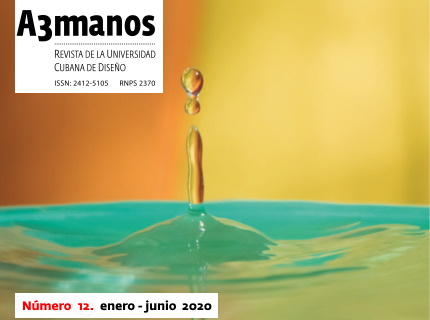The emotional design in the training process of the cuban industrial designer.
##plugins.themes.bootstrap3.article.main##
Abstract
In the search for design solutions that adjust more and more to the demands and needs of users, there have emerged trends oriented towards the development of products that are not only functional and useful, but also that make a difference when producing pleasurable sensations and experiences in the user. Such approach considers both cognitive and emotional aspects and is called emotional design. It has its own methodologies for product designing and is characterized by a deep analysis of the user, considering their experience and the affective bond that is created from the interaction with the product.
As part of the process of continuous transformation of curricula, many universities and institutes linked to design and architecture include emotional design in the process of training their students and professionals. In the case of Cuba, an analysis of the curriculum E of the industrial design career of the Higher Institute of Design (ISDi), shows that the knowledge that makes up the emotional design has not been incorporated in the syllabus yet in a structured and conscious way. Hence, the objective of this work is to make a general analysis about emotional design to identify the content that needs to be used to shape an optional subject that allows teachers to create a culture around this approach and for it to become an inherent part of the designing process.
##plugins.themes.bootstrap3.article.details##

This work is licensed under a Creative Commons Attribution-NonCommercial-ShareAlike 4.0 International License.
- Attribution — You must give appropriate credit , provide a link to the license, and indicate if changes were made . You may do so in any reasonable manner, but not in any way that suggests the licensor endorses you or your use.
- NonCommercial — You may not use the material for commercial purposes .
- No additional restrictions — You may not apply legal terms or technological measures that legally restrict others from doing anything the license permits.
- ShareAlike — If you remix, transform, or build upon the material, you must distribute your contribution under the same license as the original. NOTE: This point applies to numbers 1 to 20 of the magazine with the previous CC-BY-NC-SA 4.0 license. Does not apply to the new CC BY-NC 4.0 license from Volume 11, Number. 21 (2024).
References
Felgueroso I. et al. (2011). Diseño Afectivo e Ingeniería Kansei. Guía metodológica. Gijón: Fundación PRODINTEC. Recuperado de www.prodintec.com.
Pérez M. y Peña S. (2014). Diseño. Una definición integradora. A3manos. Revista de la Universidad Cubana de Diseño. No. 1, 21–37.
Jordan, P. W., (2000) Designing pleasurable products: An introduction to the new human factors. Taylor & Francis.
Maslow A. (1943). A Theory of Human Motivation.
Norman D. (2004). Emotional Design. Why We Love (or Hate) Everyday Things. New York: Basic Books.
Desmet P. (2002). Designing Emotions. Tesis de doctorado. Delft University of Tech¬nology. Delft, Holanda.
Maya J. (2017). D+E: fundamentos, problemática y soluciones pedagógicas. Economía Creativa. (08), 115-157.
Van Hout M. (2008). Comprendiendo, midiendo, diseñando (para la) emoción. Faz. Diseño de interacción, 2, 88-97. Recuperado de: http://www.revistafaz.org/articulos_2/08_emociones_vanhout.pdf
Instituto Superior de Diseño (ISDi). (2016). Plan de estudio E de la Carrera de Diseño Industrial. Ministerio de Educación Superior, Cuba.
Bibliografía
Alpízar H.Y. y Salas D. E. (2010). El papel de las emociones positivas en el desarrollo de la Psicología Positiva. Wímb lu, Revista Electrónica de estudiantes de la Escuela de Psicología, Universidad de Costa Rica, 5(1), 65-83.
Barragán A. R. y Morales C. I. (2014). Psicología de las emociones positivas: generalidades y beneficios. Enseñanza e Investigación en Psicología, 19 (1), 103–118.
Cardona G. M y Obando C. (2010). Estado del arte del diseño emocional. Universidad de San Buenaventura. Medellín. Recuperado de: http://repositorios.rumbo.edu.co/bitstream/handle/123456789/96326/Estado_Arte_Diseno_Obando_2010.pdf?sequence=1&isAllowed=y
Fernández A. M. (2011). Antropología de las emociones y teoría de los sentimientos (1). Revista Versión Nueva Época, 26, 1–24.
Horruitiner P. (2006) La universidad cubana: el modelo de formación. La Habana: Editorial Félix Varela.
Ministerio de Educación Superior (MES). (2018). Resolución 2/2018. La Habana: Gaceta Oficial de la República de Cuba.
Ostrosky F. y Alicia Vélez A. (2013). Neurobiología de las emociones. Revista Neuropsicología, Neuropsiquiatría y Neurociencias,13, (1), 1-13.
Peña S. (2015). Diseño con sentido. A3manos. Revista de la Universidad Cubana de Diseño, 3, 25–34.
Pérez M. (2014). La formación de Diseñadores Industriales en el ISDi. A3manos. Revista de la Universidad Cubana de Diseño, 1, 67–86.
Pérez M. y Peña S. (2015). Diseño. El objeto de la profesión. A3manos. Revista de la Universidad Cubana de Diseño, 2, 5–26.
Petruska Gatica P. P. (2015). Diseño y emoción. La vinculación de dos conceptos como propuesta cultural. Tesis de doctorado. Universitat de Barcelona. Recuperado de: http://diposit.ub.edu/dspace/bitstream/2445/96384/1/PPGR_TESIS.pdf.
Piqueras J., Ramos V., Martínez A y Oblitas L. (2010). Emociones negativas y salud. Av. Psicol. 18(1), 33-57.
Subiela S. (2009). Lo personal de los objetos. El rol de las emociones en el diseño. Tesis de grado. Universidad de Palermo. Recuperado de: https://fido.palermo.edu/servicios_dyc/proyectograduacion/archivos/775.pdf
Vergara M. y Mondragón S. Ingeniería Kansei. (2008) Una potente metodología aplicada al diseño emocional. Faz. Diseño de interacción, 2, 46-59. Recuperado de: http://www.revistafaz.org/articulos_2/04_ingkansei_vergara_mondragon.pdf.






















